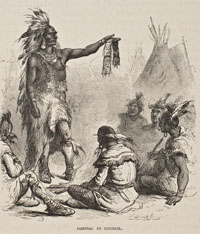Pontiac (died 1769)

The Native American uprising of 1763 was called Pontiac's War or Pontiac's Rebellion, named for the Ottawa chief who led the siege against Fort Detroit and whom some British officials identified as the architect of a vast native conspiracy in the region. The conflict discredited the recent British approach to diplomacy in the region, in which French strategies of accommodating cultural differences and reinforcing relationships through gifts had been abandoned. The war also put significant pressure on British officials to quell the discord between natives and colonials in the contested regions west of the British provinces.
Pontiac himself remains somewhat of a mystery; historians have scant evidence from which to construct his biography. Neither he nor his Ottawa contemporaries left behind writings that might explain his motives or ideas. No contemporary portrait of Pontiac exists. The documentary record of Pontiac's life that does exist is marred by flaws: possibly unreliable authors, diary entries altered years after the fact, and other interpretive difficulties. Scholars have estimated that he was born around the late 1710s or 1720, was raised somewhere around western Lake Erie, and by many reports he was said to be a charismatic military leader. Nineteenth-century historians such as Francis Parkman portrayed Pontiac as a transformative figure, personally coordinating an intertribal alliance and serving as the master strategist of the fighting. However, most modern historians have ascribed a less pivotal role to Pontiac, suggesting that while he was a major figure in the attack on Fort Detroit, many of the other seemingly coordinated attacks of the war were merely inspired by Pontiac's actions or just coincidental with them.



